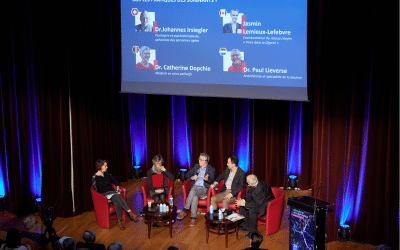On Friday September 18, 2015, Kathy Niakan, scientist working on stem cells at the Crick Francis Institute in London, had requested the “Human Fertilization and Embryology Authority » (HFEA), the U.K. governmental regulatory organization for fertility techniques, a license to perform genome-editing on human embryos.
On January 14, the British regulatory committee is assessing the request. In a press conference, Kathy Niakan went over the reasons for her request. The scientist conducts destructive research on human embryos derived from in vitro fertilizations and which are not wanted. She studies the fertilized ovule transfer to blastocyst, a structure which is then implanted in the mother’s uterus. The blastocyst contains several types of cells: those intended to become the fetus and those which become the placenta and the yolk sac. Kathy Niakan tries to understand fundamental biological aspects in the human embryos’ early development and the role of some specific genes, which could have clinical implications in infertility, miscarriages, development problems, and therapeutic applications of embryonic stem cells.
The researchers have already identified several thousand genes which are active in the embryo, the scientist and her team are working to identify those which are the principle regulators of development, and hope to employ the CRISPR-Cas9 technique to inactivate or activate the genes, and thus better understand their specific functions. The human embryos used for this purpose would be destroyed within seven days of development.
If the HFEA grants this request, Kathy Niakan hopes to start this research in a few months time, even if the project must also be approved by the British equivalent of an institutional examining committee.
During the press conference, Kathy Niakan was accompanied by her close collaborator Robin Lovell-Badge, very pro-active on this issue in the United Kingdom and in international debates on human gene editing. He has been on the organizational committees for the international summit in Washington and the joint statement in support of research and funding methods of gene editing by the Academy of medical science and several counsels and associations signed on September 2, 2015.
The director at Nuffield Council on Bioethics, the more reserved Hugh Whittall, declared: “The DNA editing performed for research purposes cannot be used for treatment purposes. However, this opens the doors to scenarios of gene editing to correct a genetic disease with the idea of creating a genetically modified embryo in order to give birth to a child. This research gives rise to a number of important questions which need to be addressed before research work begins.”
The Nuffield Council on Bioethics is currently achieving an online public survey to clarify the examination of ethical questions raised by this technique of gene editing.
England is thus advancing by giant leaps and bounds on the question of employing CRISPR-Cas9 for gene-editing on human embryos. For Alliance VITA, this is a major preoccupation. Using the human embryo simply as ‘raw material’ for research raises serious ethical questions. Although this technique might be promising for genetic therapy, Tugdual Derville reminds us that when applied to the human embryo: “the danger is to cause the emergence of custom-made babies, with pre-selected genetic criteria, transmissible modifications, with unknown consequences for future generations. The human genome is part of our most precious “heritage of humanity”. Its’ integrity must absolutely be preserved for future generations.”



